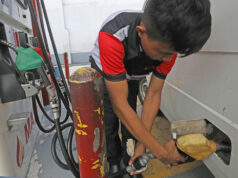Marcos sees Philippine and US troops fire at mock enemy ship

By Kyle Aristophere T. Atienza, Reporter
PHILIPPINE President Ferdinand R. Marcos, Jr. on Wednesday witnessed a live-fire sea drill between the Philippines and United States armed forces near the South China Sea, as the allies near the end of their largest-ever war games.
The drill — the highlight of the Balikatan (shoulder-to-shoulder) exercises between the two countries this year — involved the sinking of a World War II-era Philippine Navy ship that was decommissioned in 2021.
The vessel 12 nautical miles off the coastal waters of San Antonio, Zambales in northern Philippines was treated as an enemy vessel.
About 1,400 marines, soldiers, sailors, airmen and coastguards from both countries took part in the drill, which “involved detecting, identifying, targeting and engaging a target ship using a variety of ground and air-based weapons systems,” the Presidential Communications Office said in a statement.
The exercise featured US and Philippine weapon systems including the High-Mobility Artillery Rocket Systems (HIMARS) and Avenger air defense systems, which delivered coordinated fires on the target ship.
“HIMARS is a C-130 air transportable wheeled launcher mounted on a five-ton Family of Medium Tactical Vehicles XM1140A1 truck chassis organic/assigned to field artillery brigades,” the presidential palace said.
Built to support an “expeditionary, lethal, survivable and tactically” mobile force, the HIMARS carries one launch pod containing either six Guided MLRS rockets or one Army Tactical Missile System.
Temario C. Rivera, a retired professor of international politics at the University of the Philippines, said the drills that involved the use of advanced missile weaponry and sinking of a mock enemy ship “could only lead to the worsening of tensions” in the Philippines’ exclusive economic zone in the South China Sea.
It also posed threats to the Philippines’ relations with China, the Southeast Asian nation’s largest trade partner, he said.
“While we can develop a minimum military deterrence, this should not be held hostage to the strategic security priorities of the US that are not necessarily aligned with our core national interests,” Mr. Rivera said in a Facebook Messenger chat.
“In negotiating our relations with the major powers, we should rely mainly on innovative and agile political and diplomatic initiatives in exploring peaceful approaches to the conflict in the region.”
San Antonio, Zambales is about 140 miles from Scarborough Shoal, which China claims. In 2016, an international court ruled both Chinese and Filipino fishermen have the right to engage in traditional fishing there. China has ignored the ruling.
During the littoral live-fire event, a US Marine Corps command and control and sensor network enabled various firing platforms to sense their target, develop firing solutions and deliver precision-integrated fires against the target vessel, according to the palace.
The drill was also participated in by Armed Forces of the Philippines Chief of Staff Andres Centino, National Security Adviser Eduardo Año, Zambales Rep. Doris Maniquiz and Zambales Governor Hermogenes Ebdane, Jr.
US Ambassador to the Philippines MaryKay Carlson, US Deputy Assistant Secretary of Defense for South and Southeast Asia Lindsey Ford and US Exercise Director William Jurney were also present.
STRONG SIGNAL
Security expert Chester B. Cabalza said the Philippine president’s presence at the live-fire drill sent a strong message to China that Manila and Washington are “geared toward collective deterrence in protecting what is ours and obey maritime rule-based norms.”
“His presence was a solid rock to Philippine claims in the Scarborough Shoal and other maritime features in the West Philippine Sea,” Mr. Cabalza said via Messenger chat.
His presence could lead to a “swift shift” of the Armed Forces of the Philippines to external defense, he added.
“This is contrary to the defeatist posture of the Philippines. It brings out the fighting spirit of the Philippines in our assertive claims in the West Philippine Sea.”
The so-called Balikatan exercises this year started on April 11 and will end on April 28. Almost 18,000 soldiers from both sides participated in the drill. There were observers from Japan, South Korea, the United Kingdom, France, India and Southeast Asian countries.
“Mr. Marcos being there himself is just a manifestation of every president’s desire to project a strong military commander persona,” Michael Henry Ll. Yusingco, a policy analyst, said via Messenger chat.
“The president’s presence shows to the troops that he can be a battlefield commander himself,” he said. “It’s all about perception because these kinds of events are tightly scripted.”
But Mr. Yusingco noted that if the president’s presence at the drill was meant to send a strong signal to China, “it’s counterintuitive to the administration’s policy of neutrality.”
Lucio B. Pitlo III, a research fellow at the Asia-Pacific Pathways to Progress Foundation, said the Philippine leader’s decision to witness the drill “signals the importance of the alliance with the US for the country’s security.”
But the government appears committed to its economic partnership with China, he said in a Messenger chat.
In February, Mr. Marcos allowed wider American access to Philippine military bases under their Enhanced Defense Cooperation Agreement (EDCA).
China has criticized the expansion, accusing Washington of endangering regional peace and stability.
EDCA banks on the 1999 visiting forces agreement and 1951 Mutual Defense Treaty between the Philippines and US.
In September 1991, Filipino senators voted to end a century of US military presence in the Philippines.
The military base treaty would have given the US 10 more years to maintain Subic Naval Base, one of its most strategic bases in the Southeast Asian nation. A year before this Mt. Pinatubo’s eruption forced the US to abandon Clark Airbase in Pampanga province. The two former US bases are now economic hubs in central Luzon.



